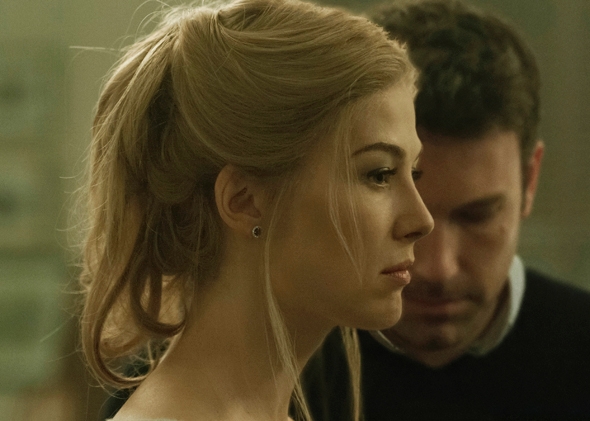Gone Girl
Beautiful, sexy, and fascinatingly mean.

Photo by Merrick Morton/Twentieth Century Fox and Regency Enterprices
After you've seen Gone Girl, come back and listen to Slate’s David Haglund, Dan Kois, and Dana Stevens discuss the movie in our Spoiler Special.

David Fincher’s Gone Girl presents a succession of shimmering surfaces, each more seductive and opaque than the last. That’s not the only way in which this film (adapted by Gillian Flynn from her own best-selling novel) could be said to resemble its title character, the mysteriously missing Amy Elliott Dunne (Rosamund Pike). Amy is polished, perfectionistic, coolly cerebral, and sometimes startlingly cruel. So is Fincher’s ninth film, a deliciously manipulative mystery that toys with the viewer like a femme fatale with her prey.
Wait, did I just compare a movie about a manipulative woman to a manipulative woman? That’s a pretty weird metaphor, genderwise—and it only gets weirder when you observe that said movie, while written by a woman, is directed by a man who has often been criticized for making films that either ignore or objectify their female characters. And that the real protagonist of Gone Girl is not the missing Amy at all, but her left-behind husband Nick (Ben Affleck), who is himself something of a closet misogynist. Whatever is going on with gender and sexuality in Gone Girl—and I’m not sure I get just what is going on—it’s more complicated than simply “man makes woman-hating movie.” But I’ll stand by that femme fatale metaphor for now, because at the most basic level, it works: Like a film noir siren Gone Girl is beautiful, sexy, and fascinatingly mean—a nasty but estimable piece of work.
Flynn’s novel—to which her script is broadly faithful, with a few omissions and compressions—pivoted on a central twist around which I’ll try to write loop-the-loops (though the ubiquity of that book on subway cars in the two years since its publication suggests many viewers will know it already). For me, the book—spellbinding for the first hundred or so pages—lost much of its momentum after that reveal, as the plot mechanisms clanked a little too audibly into gear. But Gone Girl the film is sleekly assembled and briskly paced, feeling much shorter than its actual running time of 2½ hours. And well after the big reveal (which comes around an hour into the film) there are many more skillfully executed rug-pulls to come. This may be one of those cases in which the adaptation surpasses the original: Gone Girl the movie strikes me as more complex, more suggestive, and more problematic—richly so—than Gone Girl the book. It’s a crime story that, as with Fincher’s serial-killer movies (Seven, Zodiac), is about something larger than the individual mystery it investigates. Questions of identity and representation, knowability and unknowability, truth and illusion are woven into the fabric of the plot, not laid on top of it in the form of “themes.”
How to give a sense of that densely woven story without giving too much away? On the morning of Nick and Amy Dunne’s fifth anniversary, she disappears from their house in Nick’s small Missouri hometown, where they’ve recently moved after the recession cut short their glamorous early years together as journalists in New York (a period Amy reconstructs for us breathlessly in a series of flashbacks, narrating her own diary entries about their romantic courtship). Conditions in the Dunne house—a shattered glass coffee table, flecks of blood on the kitchen wall—suggest an abduction or worse, and two local detectives, Boney (Kim Dickens) and Gilpin (Patrick Fugit), are called in to investigate.
As the days go by and the hunt for Amy goes nowhere, things begin to look bad for Nick. His alibi can’t be corroborated, his answers to the detectives’ questions sound slippery, and his nervous grinning at a press conference does nothing to help his case. Soon the cable news shows have picked up on the story—after all, we’re talking about a beautiful missing white woman here—and news vans surround Nick’s house, driving him to hole up at the home of his twin sister, Margo (the very good Carrie Coon). Amy’s WASP-y parents (David Clennon and Lisa Banes), who fly in from the East Coast to help with the search, soon grow suspicious of their son-in-law as well.
The last hour and a half of Gone Girl can be talked about only elliptically for fear of spoilage, but you are permitted to know that it involves Neil Patrick Harris as Amy’s rich ex and Tyler Perry as Nick’s flashy seen-it-all lawyer. As the investigation and the flashbacks continue to drill down into Nick and Amy’s story, their marriage gets examined and re-examined from both their perspectives; each successive chapter shows both partners in an ever less flattering light.
The simple fact of the bifurcated perspective—the two different versions of Amy and Nick’s marriage we hear—makes for a formidable acting challenge for Affleck and Pike. They must play their characters at every moment as people who both might and might not be liars, cheaters, even killers. Affleck, whom I’ve never warmed to as an actor (I prefer him as a writer and director), is better than he’s ever been—or maybe it’s just that this role is well-suited to his limitations as a thespian. Affleck’s resting expression—a noncommittal, averted-eye stare—has always communicated to me a vague sense of untrustworthiness. His Nick isn’t a high-strung neurotic like the one in the novel, but Affleck is more than buyable as a moderately intelligent lug resentfully aware that he’s married above his station. And Pike—who for most of her time onscreen plays the eternally self-possessed Amy with a Hitchcock blonde’s icy refinement—turns what could have been a clichéd woman-of-mystery role into a chance to show us the fragility of Amy’s cool-girl armor.
Gone Girl looks and sounds sensational, with elegant gray-and-green toned cinematography by longtime Fincher collaborator Jeff Cronenweth and an eerie (if a little too omnipresent) electronic score by Trent Reznor and Atticus Ross, who also wrote the fine music for Fincher’s The Social Network. The link between eroticism and violence, present beneath the surface throughout, becomes explicit in one virtuosically filmed late sex scene that’s gross, graphic, and horrifyingly gorgeous.
There’s no way to wade into the stickier wickets of Fincher and Flynn’s gender politics without giving away large chunks of the mystery plot. But there are moments, several of them, in which Nick’s unsavory feelings about his complicated missing wife and about women in general—feelings that might be charitably summed up as “bitches be crazy”—seem indistinguishable from the filmmaker’s own vision of Amy as a black hole of ineffable female needs, moods, and desires. Does this make Gone Girl a sexist movie? A movie about sexism that isn’t fully in control of its tone? Or some unholy hybrid of the two?
After two viewings in the space of one week, I’m still not sure where I come down on that question, or on the tone of Gone Girl’s final scenes, which can’t quite sustain the novel’s ending note of ominous open-endedness, and instead trail off in a few last bursts of ever-sourer irony. The very last shot, though—a bookend to the very first, in which we see the back of Amy’s head in close-up as Nick contemplates the fragility and shatter-ability of his wife’s lovely skull—takes the film back to what it does best: exploring the potential crime scene that lurks inside every marriage, and measuring the frighteningly short distance between domestic détente and homicidal rage.
